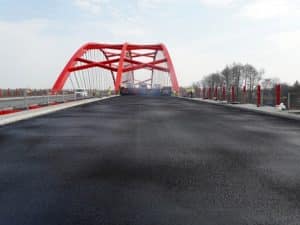Case Study
Mastic Bridge Deck
 Introduction
Introduction
Mazury, the northeastern region of Poland, is famous for its 2,000 post-glacial lakes. While inherently beautiful, the hilly landscape – covered with lakes, rivers and streams – does not lend itself easily to new roadway construction.
Challenge
In 2015, GDDKiA Olsztyn (asset owner) signed a contract with Budimex S.A. (general contractor) for a bypass and expressway around the city of Ostróda for a total of 1 billion PLN. The project consisted of several bridges, including an extra dosed bridge, MS-3 along DK16. The MS-3 bridge would be 28 m (92 ft) wide and span a total of 677 m (2,221 ft) – stretching over a creek, two existing roadways and two animal passageways. The construction required the highest quality, sustainable, and rut-resistant bridge deck pavement.
Resolution
The pavement solution came in the form of a HiMA technology-enabled mastic asphalt. A leading polymer modified bitumen (PMB) producer in Poland, Lotos Asphalt, formulated and produced the PMB. The final structure consisted of 25 cm (10 in) of the reinforced concrete bridge deck, waterproofed methyl methacrylate membrane, and two 4 cm (1.6 in) layers of mastic asphalt, including 11 modified with 45/55-80 HiMA. Asphalt mastic production temperature was between 190-210°C (374 – 410°F). The material experienced up to eight hours of transport at 200°C (392°F). Subsequently, it was compacted between 200-220°C (392-428°F). Despite the high polymer content, the contractor did not observe any particular difference from conventional mastic bitumen. The job was completed in 2017 and resulted in a permanent deformation-resistant bridge deck that continues to perform today.
